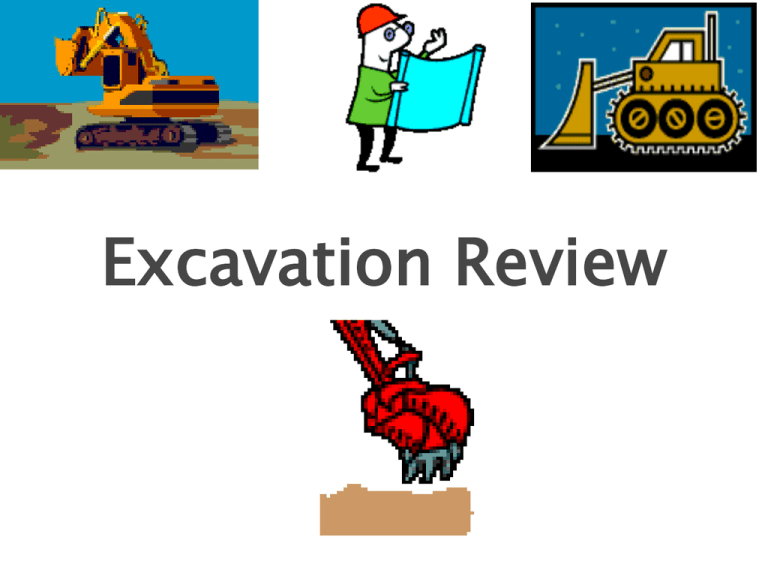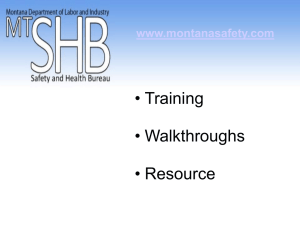Presentation
advertisement

Excavation Review 1 Why is OSHA Important to You? OSHA began because, until 1970, there were no national laws for safety and health hazards. On average, 12 workers die every day from job injuries Over 5,600 Americans die from workplace injuries annually Over 4 million non-fatal workplace injuries and illnesses are reported 2 History of OSHA OSHA stands for the Occupational Safety and Health Administration, an agency of the U.S. Department of Labor OSHA’s responsibility is worker safety and health protection On December 29, 1970, President Nixon signed the OSH Act This Act created OSHA, the agency, which formally came into being on April 28, 1971 3 OSHA’s Mission The mission of OSHA is to save lives, prevent injuries and protect the health of America’s workers. Some of the things OSHA does to carry out its mission are: ◦ developing job safety and health standards and enforcing them through worksite inspections, ◦ maintaining a reporting and recordkeeping system to keep track of job-related injuries and illnesses, and ◦ providing training programs to increase knowledge about occupational safety and health. 4 Who is covered by the OSH Act? • Most private sector employees • Coverage is provided directly by federal OSHA or through an OSHA-approved state program • OSH Act does not apply where other Federal agencies exercise authority over occupational safety and health • In Mississippi OSHA does not cover city, county and state employees. 5 Fatality Reporting Must report within 8 hours. Reports may be filed by calling: 601 - 965 - 4606. 1 - 800 - 321 - OSHA. Must talk to someone. Can not leave a message. Failure to report a fatality or catastrophe can result in a $5,000.00 penalty. 6 Temporary Workers "We are seeing untrained workers – many of them temporary workers – killed very soon after starting a new job. This must stop," said Michaels. "Employers must train all employees, including temporary workers, on the hazards specific to that workplace – before they start working. National Fall Stand Down OSHA has launched an official national safety stand-down website with information on how to conduct a successful stand-down. To learn how to partner with OSHA in this standdown, visit: http://www.osha.gov/StopFallsStandDown/. New Release – March 19th Kick-Off – June 2nd Event – June 2nd – 6th 9 Excavation Hazards Cave-ins are the greatest risk Other hazards include: Asphyxiation due to lack of oxygen Inhalation of toxic materials Fire Moving machinery near the edge of the excavation can cause a collapse Accidental severing of underground utility lines 10 Myth or Reality If I am working in a trench less than 5 feet in depth, I don’t need to worry about cave-in protection? 11 Injury and Death • Excavating is one of the most hazardous construction operations • Most accidents occur in trenches 5-15 feet deep • There is usually no warning before a cave-in 12 Cave-in Hazard This excavation has inadequate support posts and egress access Inadequate protective system 13 Inadequate Protective System This worker is in a trench with no protective system, that is not sloped or benched and has no means of egress 14 Trenching Fatality “We could not use the trench box because the trench was not straight!” 15 5 Days Before Christmas! “But he was only going to be down there for 5 minutes!” 16 Underground Utilities The estimated location of utilities shall be determined prior to the start of excavation work. Utility owners shall be contacted in order to determine the exact location of the utilities. Underground utilities shall be protected or removed to safeguard employees. 17 Access Designed by competent person < 25’ from employees 18 Access and Egress 19 Public Vehicular Traffic Employees exposed to vehicular traffic shall be provided with and shall wear warning vests or other suitable garments marked with or made of reflective or high-visibility material. 20 Falling Loads No employee shall be permitted underneath loads handled by digging or lifting equipment. 21 Don't You Feel Like Doing This To At Least One Person A Day? Don't you feel like doing this to at least one person a day?? Competent Person A person who is capable of identifying existing and predictable hazards in the surroundings, or working conditions which are unsanitary, hazardous, or dangerous to employees, and who has AUTHORIZATION to take prompt correction measures to eliminate them. 23 Competent Person Must have had specific training in and be knowledgeable about: •Soils classification •The use of protective systems •The requirements of the standard Must be capable of identifying hazards, and authorized to immediately eliminate hazards 24 Hazardous Conditions The weight and vibrations of the crane make this a very hazardous condition. They should not be working under this crane. 25 Spoils • Don’t place spoils within 2 feet from edge of excavation • Measure from nearest part of the spoil to the excavation edge • Place spoils so rainwater runs away from the excavation • Place spoil well away from the excavation 26 27 Inspections of Excavations A competent person must make daily inspections of excavations, areas around them and protective systems: • Before work starts and as needed, • After rainstorms, high winds or other occurrence which may increase hazards, and • When you can reasonably anticipate an employee will be exposed to hazards. 28 Inspections of Excavations If the competent person finds evidence of a possible cave-in, indications of failure of protective systems, hazardous atmospheres, or other hazardous conditions: Exposed employees must be removed from the hazardous area Employees may not return until the necessary precautions have been taken 29 30 Site Evaluation Planning Before beginning excavation: Evaluate soil conditions Construct protective systems Test for low oxygen, hazardous fumes and toxic gases Provide safe in and out access Contact utilities Determine the safety equipment needed 31 32 USDOL – OSHA Jackson Area Office 100 W. Capitol Street Suite 749 Jackson, MS 39269-1620 601-965-4606 Press 1 then 4606 33






